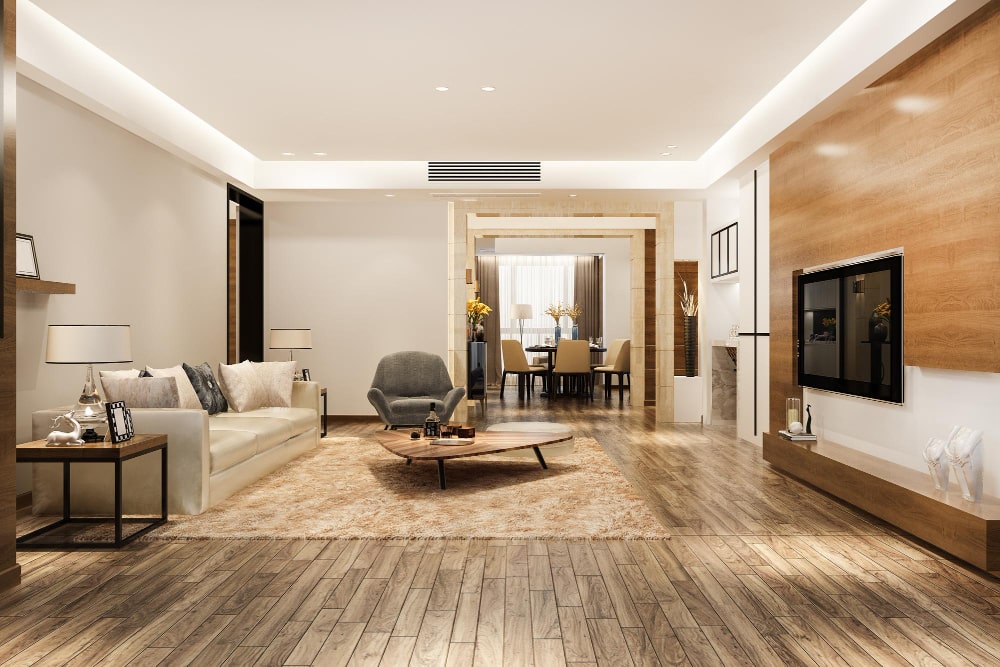
Your choice of flooring for your home is a significant one. It must appear attractive and perform well. Both can be found on a wooden floor. Which wooden floor type should you pick, though, with so many options available?
In this post, we’ll evaluate the costs, upkeep requirements, and lifespans of the various varieties of wooden floor. From solid wood and engineered wood to laminate, luxury vinyl plank, bamboo, cork and even wooden floor tiles; we’ll help you determine which option is best for your home or workspace.
So if you’re considering a wooden floor but don’t know where to start also want to be fully assured about your choice–then keep reading.
1- Solid Wood Flooring
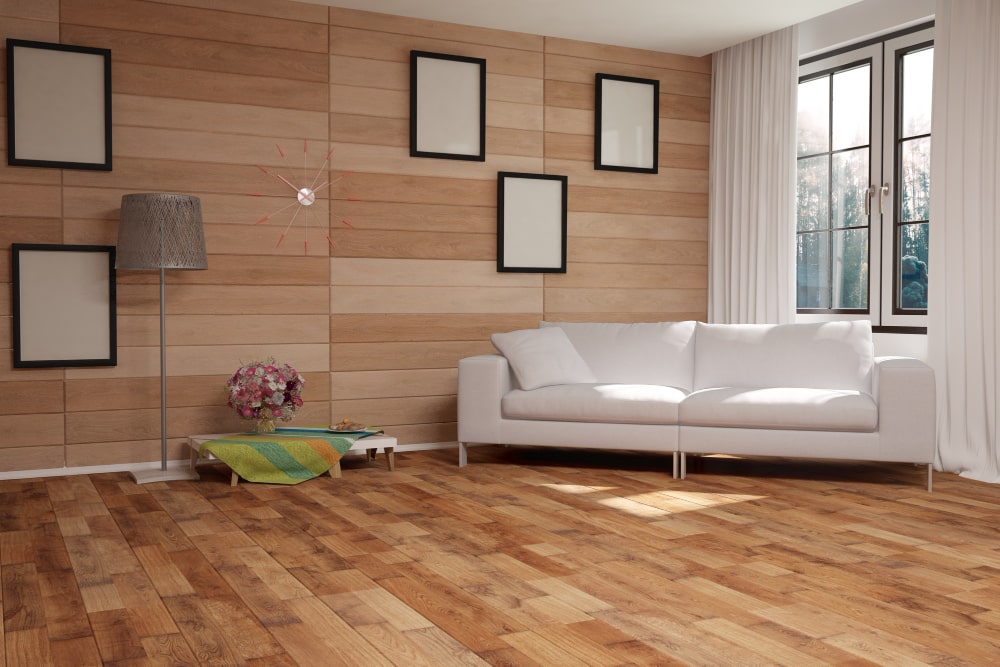
Solid wood flooring should be at the top of your list If you want to bring the classic look and feel of high-quality hardwood into your home. It is considered one of the best materials for its timeless beauty, durability, and classic warmth.
Solid wood flooring is generally more expensive than other types of wooden floor. Typical installation costs range from 200-1000 INR per sq. ft. Maintenance-wise, a proper deep clean is recommended every three months, which will ensure that dirt and dust do not accumulate in the grooves or between planks over time. With proper maintenance and care, this type of flooring can last up to 100 years. with proper Its safe to say that it is one of the most durable flooring options available in the market.
a- Cost: Expensive, Especially Exotic Wood Species
When it comes to cost, its relative. On one hand, solid wood flooring is more affordable than you might expect. On the other, the cost of certain exotic species—like Brazilian cherry and mahogany—can be expensive.
Different type of product requires different cost of installation, depending upon the complexity of the job. The simplest installations can cost around 150 to 500 INR per square foot, while complex ones can add up to as much as 1100 INR per square foot!
If money is a concern, consider engineered wood flooring. Quality engineered wood flooring costs about the same as solid wood and is usually cheaper to install—especially if you do it yourself! It also comes in an array of finishes that mimic natural wood.
And if you want both affordability and durability, laminate wood flooring is your best bet. Prices start from less than 100 INR per square foot, but can easily reach up to 650 INR or more for top-of-the-line items. It’s also easy to install, so you can save even more on installation costs!
b- Maintenance: Requires Regular Sanding, Staining and Sealing
Solid wood flooring takes a little more maintenance than the other forms of hardwood flooring. Every 5-7 years, it typically needs to be sanded, stained, and sealed with a protective coating. This is due to the fact that solid wood absorbs moisture, which over time may lead it to expand or contract. This implies that it needs to be treated frequently in order for your flooring to maintain their aesthetic appeal and long-term durability.
In order to effectively remove the old finish and sealer, remove any wax accumulation, smooth out any irregularities, remove small scratches and imperfections, and apply stain or dye before reapplying the sealant, specialised tools and supplies must be used.
You should also routinely wipe down hardwood floors with a moist cloth in addition to this process. Never use too much water when cleaning your floors! Weekly vacuuming is also a good idea. And if you want to go the extra mile with maintenance, apply a special cleaning solution every couple of months—but be sure to test any cleaning products in an inconspicuous area first.
c- Lifespan: Can Last 50-100 Years With Proper Care
When it comes to lifespan, wood flooring can last for decades—if you give it the proper care. Solid wood is oftentimes the longest-lasting type of wood flooring, boasting a lifespan of up to 100 years with the proper maintenance.
Engineered wood also has a pretty impressive lifespan, lasting between 40-80 years if taken care of properly. Laminate and Luxury Vinyl Plank (LVP) Flooring come in around 20 years, while Bamboo and Cork come in at around 25 years.
The key to increasing the lifespan of your wood flooring? Proper maintenance. This includes:
- Regular sweeping and vacuuming to remove dirt and dust
- Quickly mopping up spills and splashes before they have a chance to seep into the wood
- Applying matching finish coats when needed to keep your floors shiny, smooth and sealed against water penetration
- Finishing any repairs with a color matched repair kit
- Keeping your home an appropriate temperature (humidity) throughout the year
- Using proper mats or rugs that are designed for hardwood floors.
Keeping these maintenance tips in mind will help ensure that your wooden floor can last you for many years!
2- Engineered Wood Flooring
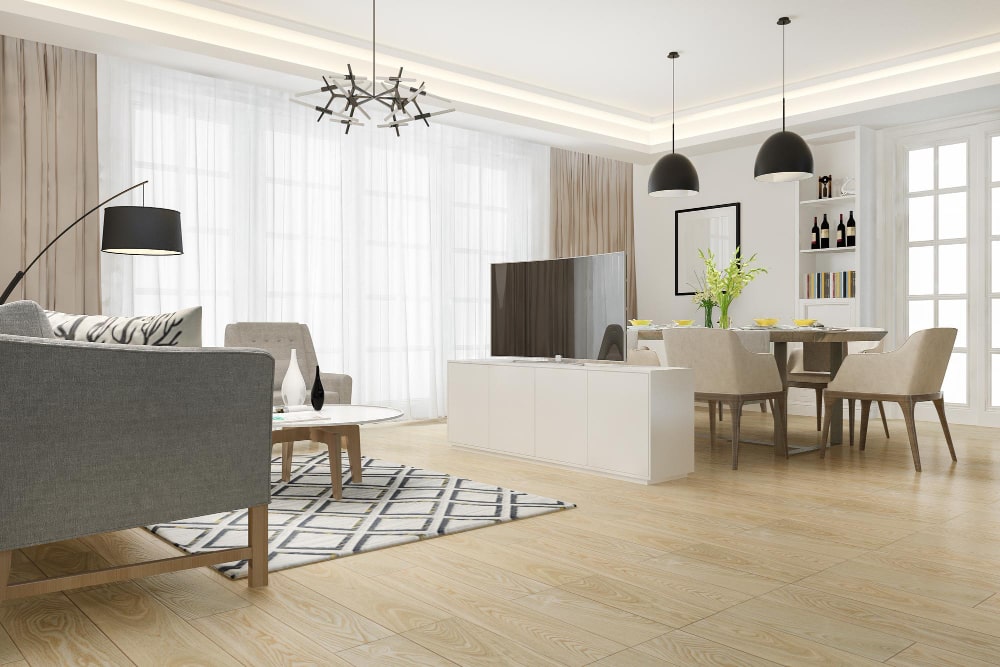
There is engineered wood flooring available for people who want the look and feel of solid wood flooring without the hassle or cost. Multiple layers of plywood and wood are combined to create engineered wood, a synthetic substance.
In reality, the bottom layer contains an artificial backing that boosts its cost and moisture resistance even though it appears to be made of real wood. Therefore, if you’re looking for a less priced option that’s still robust, engineered wood may be your best option.
But what are the pros and cons? Well, first off, engineered wood flooring tends to be cheaper than solid wood. That’s because it has fewer materials in it, so you’re getting less value for your money overall. However, engineered wood can also last longer than solid wood if properly cared for—it can last over 30 years with proper maintenance!
On the other hand, as mentioned previously, engineered wood doesn’t have quite the same lifespan as solid hardwood. It may need replacing sooner if not taken care of properly. And while you don’t have to worry about warping with engineered wood due to its synthetic construction, you should still take caution not to spill any liquids on your floors or expose them to direct sunlight for prolonged periods of time.
Overall, if you’re looking for an affordable option that won’t break the bank and will still last you decades with proper care—engineered wood is a great choice!
a- Cost: Mid-Range Price, Cheaper Than Solid Wood
One of the defining factors when it comes to selecting wooden floor for your home is the cost. Depending on the type you go for, the cost can range from mid-range prices to quite expensive.
The most expensive type is solid wood flooring which can cost up to four times more than other types of wooden floor.This makes engineered wood floors a great option if you’re looking for something similar but at a lower price point. The price difference between engineered wood and solid wood is typically between 10-20%.
Laminate and luxury vinyl plank (LVP) flooring are even cheaper than engineered wood, with laminate costing around 25-30% less and LVP being around 10-15% less than solid wood. Bamboo, cork, and wooden floor tiles are all fairly affordable options as well. In fact, they can be up to 50% cheaper than solid wood depending on the type you select – so if budget is an issue, these could be worth exploring more closely.
b- Maintenance: Low Maintenance but Still Requires Some Care
When it comes to wooden floor and maintenance, low maintenance is a great thing. But that doesn’t mean you can forget about it completely—it still needs some care.
When it comes to solid wood, one of the main things you need to remember is that it requires regular refinishing, repairs if needed whenever there’s damage, and avoiding too much moisture. Engineered wood has a bit more wiggle room when it comes to maintenance since its top layer is real wood veneer—it’s more durable than solid wood and can be easily waxed or polished to keep its luster.
Laminate wooden floor is also low maintenance—all you need to do is periodically clean it with a damp mop and vacuum any dirt that’s stuck in-between the planks. You should also avoid dragging furniture over laminate flooring as well as using harsh cleaners like bleach or oil soaps, which can damage the planks.
Luxury vinyl plank offers a degree of protection not found in other types of flooring due to its water resistant properties. Cleaning should be done regularly—especially if there are any spills—with a damp cloth or mop without using abrasive cleaners on it.
Bamboo? Just make sure you avoid any spills from staining it, otherwise all you need to do is sweep and vacuum on a regular basis. Cork flooring also needs just the same amount of love and attention as bamboo does: regular vacuuming, mopping with warm water or special products designed for cork floors, and avoiding excess humidity or direct heat sources.
Finally, wooden floor tiles require regular sweeping or vacuuming—but don
c- Lifespan: Typically Lasts 20-30 Years
When it comes to wooden floor, one of the most important factors to consider is lifespan. Depending on which type of wood you’re looking at, lifespan can vary. But in general, wooden floor typically lasts between 20-30 years.
- Solid Wood Flooring: If properly maintained, solid wood flooring can last up to 25 years. It is crucial to keep this sort of flooring clean, dry, and protected from moisture and water because it needs routine maintenance and cleaning. Additionally, the lifespan can vary depending on the sort of wood you choose for your solid wood flooring.
- Engineered Wood Flooring: If properly maintained, engineered wood flooring typically has a lifespan of 15 to 25 years. Compared to solid wood flooring, engineered wood floors are more resilient and less prone to damage from moisture or humidity since they are constructed from layers of plywood and real wood veneer.
- Laminate Wood Flooring: Laminate wood flooring has a slightly shorter lifespan than other types of wooden floor—typically lasting 10-20 years. Laminate floors are extremely durable and require minimal maintenance but they tend not to last as long as solid or engineered wood floors since they cannot be sanded down or refinished when damaged due to their plastic composition.
- Luxury Vinyl Plank Flooring: Luxury vinyl plank (LVP) floors have become a popular option for homeowners in recent years due to their affordability and durability—lasting 10-20 years if taken care of properly. LVP floors are waterproof and scratch-resistant making them ideal for high traffic areas like kitchens and
3- Laminate Wood Flooring
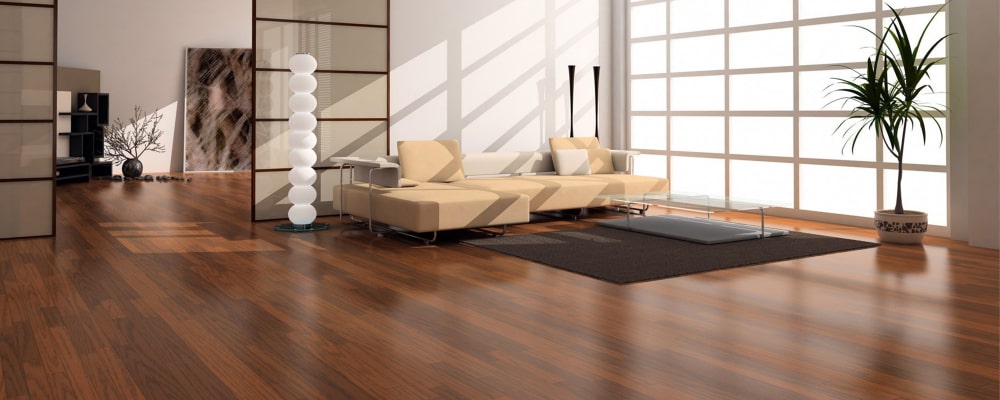
If you’re looking for a cost-effective alternative to solid and engineered wood flooring, laminate wood flooring is for you. It’s not necessarily a cheaper option than the others, but it does require less maintenance—making it the best option for manageability and longevity.
Laminate wood flooring is made up of a tough synthetic layer that’s fused to multiple layers of backing materials with high-resolution images of real hardwood printed on top. This makes it almost indistinguishable from real wood and gives your home an authentic look, while still being more durable than traditional wood!
Laminate flooring is quite affordable with prices starting at around 200 INR per square foot to up to 500 INR per square foot depending on the thickness, quality, and brand you choose. The maintenance required is minimal too: just sweep or vacuum regularly, use a damp mop when needed, and wipe up any spills immediately.
The lifespan of laminate flooring varies based on the quality but can range from 10-25 years if properly maintained—it all comes down to how well you take care of it!
a- Cost: Budget-Friendly Option
If you are in tight budget, you will find wooden flooring a little over the top. Also minding your budget while choosing wooden flooring is always a good idea. Fortunately, some types of wooden flooring are more wallet-friendly than others. In the wooden flooring category, cork may be the most budget-friendly option.
Cork is a natural product made from the bark of cork oak trees, and is usually a more affordable option than other forms of hardwood floors. It’s not quite as durable as solid wood, but can last up to 30 years with proper care.
When it comes to cost, cork is typically less expensive than engineered wood and laminate wood flooring per square foot; however, luxury vinyl plank (LVP) flooring can compare in price. It all depends on what you’re looking for in terms of esthetic and durability. In terms of installation costs, LVP and wooden tiles might be the least expensive options since they come pre-attached already to each other or with adhesive backing.
b- Maintenance: Very Low Maintenance but Susceptible to Damage
Maintaining your wooden flooring doesn’t have to be a headache, as long as you can keep up with regular cleaning and some basic preventative measures.
For example, solid wood floors are very low maintenance. You’ll just need to keep up with routine sweeping for dirt and dust, or use a vacuum on its lowest setting. You’ll also need to mop once a week with a wood-safe soap and warm water. Just make sure you don’t leave standing water on the surface of the wood, because that can cause damage over time.
Engineered wood flooring is also low maintenance—it’s even more resilient to spills than solid wood because the surface is sealed better than natural wood planks. To keep it clean and looking great for years to come, just use a microfiber mop and clean frequently.
Laminate and luxury vinyl plank floors usually come with a protective coating that helps prevent dirt buildup, so you can usually just sweep them or vacuum them using the lowest setting on your vacuum cleaner. Again, make sure you don’t leave standing water on the surface of either material!
Bamboo is probably one of the easiest materials to maintain—just sweep it regularly and give it an occasional mopping with a damp cloth.
Finally, cork requires special care; clean it once every seven to 14 days using only warm water and a damp cloth or mop. It’s important not to use any abrasive materials here—no steel wool! Also consider applying wax or polyurethane every three months or so for maximum protection against scratches and other damage.
The same goes for wooden flooring tiles: only use warm water when cleaning
c- Lifespan: Usually 10-15 Years Before Needing Replacement
Alright, so let’s talk lifespan. Overall, the lifespan of wooden flooring is usually around 10-15 years before it starts to look worn down and needs replacing.
When considering the lifespan of each type of flooring material, there are a few key things to keep in mind:
- -The type of wood used
- -How well it’s maintained
- -How much wear and tear it takes
- -The installation process
Starting with solid wood, this type of floor is one of the most durable—with proper maintenance it can last for generations. Engineered wood flooring also has a good lifespan when compared to other options but tends to wear down faster than solid wood due to its layered construction.
Laminate flooring typically wears down faster than its competitors and requires more frequent replacements. Luxury vinyl plank (LVP) and bamboo also have an average lifespan between 8-15 years, while cork averages 10-25 years depending on how well it’s maintained. Wooden tiles tend to have a shorter lifespan as they’re can be prone to water damage if not sealed properly.
4- Luxury Vinyl Plank Flooring
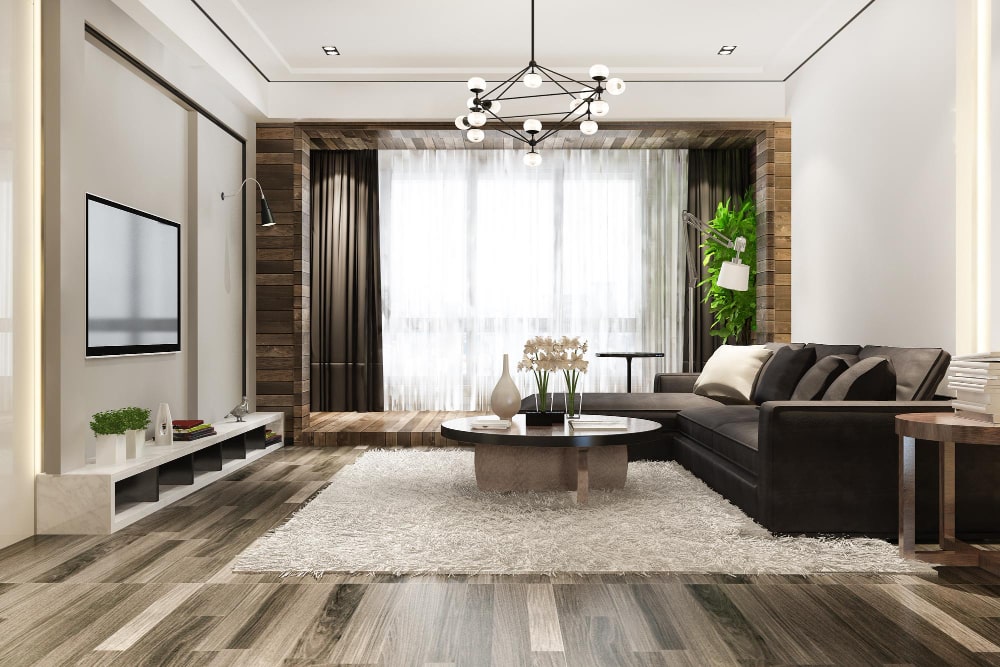
Luxury vinyl plank flooring is a type of wood flooring that combines the look and feel of traditional wood flooring with the durability and water resistance of vinyl. You can find varying thicknesses, finishes, and designs to give your home a unique look.
Plus, it’s relatively affordable when compared to traditional hardwood floors. The price point for luxury vinyl plank flooring starts at about $2 per square foot—not bad for an authentic-looking wood option.
When it comes to maintenance, this type of flooring is quite easy to care for. All you have to do is sweep or vacuum regularly, mop as needed, and use a damp cloth for tough stains. Plus, it’s water resistant—so it’s great for high-traffic areas like living rooms and hallways where moisture would cause other types of flooring to swell or warp.
And when it comes to lifespan, luxury vinyl plank can last up to 20 years if properly cared for—so you’ll surely get your money’s worth.
a- Cost: Affordable Alternative to Wood and Stone
Cost is always an important factor when making a big interior design decision, and when it comes to flooring, you don’t want to blow your budget. If you’re looking for a more affordable alternative to wood and stone, wooden flooring tiles can be the perfect solution.
One of the most budget-friendly wood flooring options on the market is wooden flooring tiles. MAde with composite material or particle board with a wooden veneer, these wooden floor tiles come in different finishes, including laminate and vinyl plank. You can customize it to fit your home’s design scheme, as these tiles come in a variety of colors and styles.
These tiles are much easier to install than solid hardwood floors, because these tiles are made from composite material or particle board — which requires specialized tools or knowledge. Wooden flooring tiles also require less maintenance than solid hardwood floors since they do not require regular sanding or staining like solid hardwood does. Plus, they are much more durable than traditional wood floors, so they will last longer.
If you want an easy to install and maintain wooden flooring, wooden tile flooring is an affordable option. These tiles look classic and will stand out in any room.
b- Maintenance: Minimal Maintenance Required, Highly Water-Resistant
Another great thing about wooden flooring is that it can be surprisingly low-maintenance. Depending on the type of flooring you have and the environment it’s in, most wooden floors don’t require much upkeep at all.
That said, if you have solid wood flooring, it will likely require more maintenance than other types of wooden floors. This is because when exposed to temperature and humidity changes, it can contract or expand, so you’ll likely need to sand and refinish it every few years. Engineered wood is more stable when it comes to environmental variations and typically requires less maintenance than solid wood—just vacuuming or sweeping with a soft broom once in a while should do the trick.
Laminate wood flooring is a great choice if you want something that’s easy to maintain as well; all it needs is regular sweeping and vacuuming regularly and wiping up spills immediately with a damp cloth. Luxury vinyl plank (LVP) floors are also moisture-resistant, so they don’t need much beyond cleaning with approved products like a pH-neutral cleaner or microfiber mop; just keep in mind that scratching can occur if mopping is too aggressive.
c- Lifespan: Usually 10-20 Years Before Needing Replacement
Bamboo floors are relatively low-maintenance too; they only need regular sweeping or dusting plus occasional damp mopping, but make sure to use only approved cleaners like those formulated for hardwood floors. Cork floors, finally, are also easy to maintain—as long as you keep them regularly dusted or vacuumed plus wipe up spills right away with a damp cloth, your cork floors should last for years without issue.
Vinyl flooring is really robust. It can endure up to 10 to 20 years if fitted and maintained correctly. Having said that, vinyl is a fantastic option for the areas of your home that see the most traffic. Additionally, the wear layer on the surface of the majority of vinyl flooring prevents stains and scratches.
5- Wooden Floor tiles
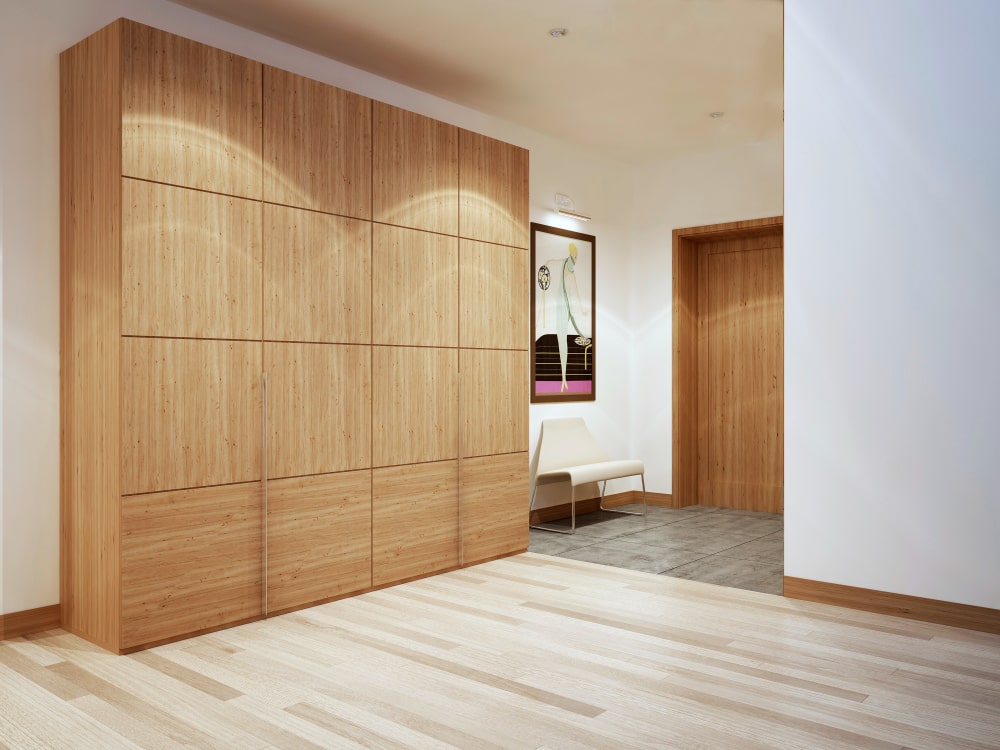
Wooden flooring tiles are a great way to add a unique and luxurious touch to your home. They are made from wood veneer, which is thinly sliced wood that is adhered to a backing board, making them incredibly durable. Since they come in various sizes and patterns, you can create an interesting floor pattern that will elevate the look of your home while still remaining low maintenance.
Since wooden flooring tiles are easy to install, they are an ideal option for anyone looking for a fast and cost-effective installation process. Wooden flooring tiles come in a wide range of prices and styles, so there is sure to be something available to fit any budget.
When it comes to cost, wooden flooring tiles usually range from $2-$6 per square foot depending on the type and quality of wood used. In terms of maintenance, these tiles are fairly low maintenance – simple sweeping and mopping with the occasional deep clean will ensure that the tiles remain in good condition for years to come. As far as lifespan goes, wooden flooring tiles typically last around 8-15 years or more depending on how often they are maintained.
Upgrade Your Wood Flooring with Cityfurnish
Selecting the right type of wood flooring involves carefully considering factors such as the type of wood, room dynamics, design preferences, tone, grain, grade, manufacturing process, plank dimensions, and finish.
By taking the time to explore these aspects, you can ensure that your chosen wood flooring not only meets your practical needs but also enhances the overall appeal of your home. At Cityfurnish, we offers an extensive selection of high-quality hardwood flooring furniture on rent. Look at our furniture rentals on rent and book your rentals today!
Parting Words
Wooden floor goes really well with wood furniture. If you want to bring in a more natural look inside your home mix and match these wooden floor with solid wood furniture.
Choosing the right kind of wooden flooring, suitable for your taste, budget and style from among so many available options—as well as how long you’d like it to last and how much maintenance it requires—can be tricky.
Having clear priorities can help immensely. Consider all the pros and cons of each type carefully and determine which option is best suited to your needs. With the right information, picking the right wooden flooring could be simpler than ever—it might just be a case of finding the type and style that speaks to you.

